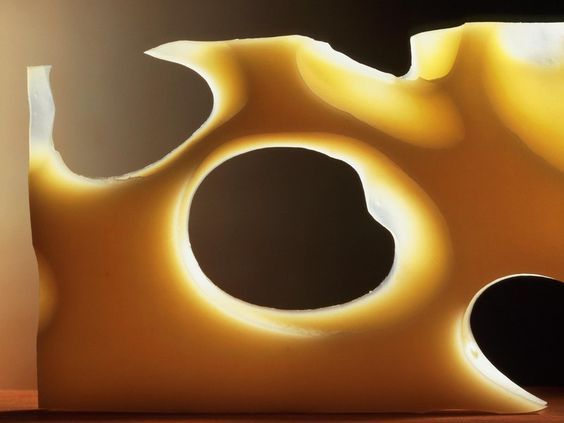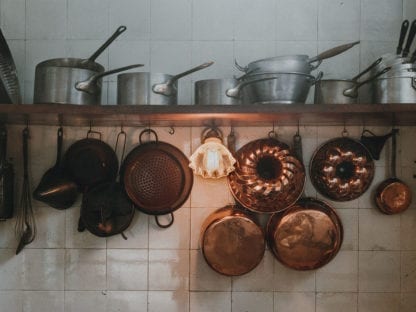Have you ever peered at a slice of Swiss cheese and wondered about the story behind its iconic holes?
It’s a quirky feature that intrigues cheese lovers and culinary enthusiasts alike, sparking curiosity and conversation.
The holes in Swiss cheese, also known as “eyes,” are formed by carbon dioxide bubbles produced by the bacteria Propionibacteria during the fermentation process.
In this blog, we’ll explore everything from the historical origins and authentic Swiss roots of Emmental cheese, to the specific microbes and cheese-making techniques responsible for those fascinating holes, offering a deep dive into the world of Swiss cheese.
Exploring the Historical Origins of Swiss Cheese

Swiss cheese is not just a delicious dairy delight; it’s a historical artifact that reflects centuries of cheesemaking tradition in Switzerland. The journey of Swiss cheese, particularly varieties like Emmental, began in ancient times when early forms of this cheese were developed in the monastic and traditional rural dairies of Switzerland. The iconic holes, or “eyes,” which characterize Swiss cheese, were initially viewed as imperfections, but over time, they became a symbol of quality and authenticity.
The evolution of Swiss cheese is deeply intertwined with the cultural and agricultural practices of Switzerland. By the 15th century, the rise of hard cheeses like Emmental marked a significant development, driven by the need to preserve milk and meet the demands of expanding urban populations. These cheeses were not only a source of sustenance but also became a vital part of the Swiss economy, enhancing its gastronomic map on a global scale.
Authenticity and True Swiss Roots of Emmental Cheese
Emmental cheese, often referred to as the king of Swiss cheeses, boasts a rich legacy that underscores its authenticity and Swiss roots. Originating from the Emmental region, this cheese is renowned for its quality and distinctive large holes, a result of natural fermentation processes. To be considered authentic, Emmental must adhere to strict production criteria, including being produced in family-run dairies in the German-speaking part of Switzerland, using natural ingredients, and following age-old methods that guarantee its unique flavor and texture.
The Crucial Role of Microbes in Swiss Cheese
Swiss cheese, renowned for its distinctive holes, owes much of its character to microbial activity. During the cheese-making process, specific bacteria are crucial not only for flavour development but also for the formation of these iconic holes. The interaction between these microbes and the cheese environment results in the production of gases that contribute to the cheese’s unique texture.
The role of these microbes goes beyond simple fermentation. As the cheese matures, the bacteria continue to interact with the cheese’s components, enhancing its flavour and contributing to the physical characteristics that make Swiss cheese so unique. Understanding this microbial activity is key to mastering the art of Swiss cheese production.
Bacteria’s Role in Crafting Swiss Cheese’s Holes

The creation of holes in Swiss cheese, often referred to as “eyes,” is primarily attributed to the action of Propionibacterium bacteria. These bacteria consume lactic acid present in the cheese, a byproduct of other bacterial activity, and convert it into carbon dioxide gas. This gas forms pockets within the cheese, leading to the formation of holes.
Propionibacterium not only helps in forming the holes but also plays a significant role in flavour development by producing acetic and propionic acids. The balance and activity of these bacteria are carefully controlled during cheese production to ensure the desired hole formation and flavour profile, demonstrating the intricate relationship between microbes and cheese characteristics.
Techniques Behind the Holes in Swiss Cheese
The creation of holes in Swiss cheese, often referred to as “eyes,” is a fascinating interplay of cheese-making techniques and microbial action. The process begins with the careful selection and treatment of milk, ensuring that it provides the perfect foundation for the cheese. Curdling is a key step where milk is transformed into curds under precise conditions, setting the stage for the unique characteristics of Swiss cheese.
As the curds are processed and pressed, they are constantly monitored and controlled for temperature and acidity. This meticulous attention to detail ensures that the Propionibacteria can thrive and produce carbon dioxide, which forms the characteristic holes. The maturation stage further influences the size and distribution of these holes, as the cheese ages in specially controlled environments.
Step-by-Step Production of Swiss Cheese
The production of Swiss cheese begins with the delivery of fresh milk, which is rigorously tested and filtered to maintain quality. The milk is then gently heated, and specific bacterial cultures along with rennet are added to initiate curdling. This process forms a gelatinous mass, which is the base for the cheese.
After curdling, the cheese mass is cut into curds and heated further, influencing the cheese’s hardness. These curds are then placed in moulds and pressed to remove whey, followed by a salt bath where the cheese absorbs salt and releases more whey, enhancing its flavour. The final stage is maturation, where the cheese develops its rind, flavour, and the iconic swiss cheese holes.
Varieties of Swiss Cheese with Holes

Swiss cheese varieties known for their holes each offer unique flavours and textures. For instance, Emmental is famous for its large holes and mild, slightly nutty flavour. Jarlsberg, although not originally from Switzerland, is often included in the Swiss cheese category due to its large holes and sweet, nutty taste, similar to traditional Swiss cheeses.
Another variety, Appenzeller, features smaller holes and a distinctly strong, herbal flavour due to its unique curing process involving herbal brine. These varieties, among others, showcase the diversity within Swiss cheeses:
- Emmental: Large holes, mild and nutty
- Jarlsberg: Sweet and nutty, with large holes
- Appenzeller: Smaller holes, strong herbal flavour
Culinary Impact of Holes in Swiss Cheese
The holes in Swiss cheese, often celebrated for their whimsical appearance, play a crucial role in defining the cheese’s texture and culinary versatility. These airy pockets contribute to a lighter and more delicate mouthfeel compared to denser cheeses, making Swiss cheese a preferred choice for dishes that require a subtle yet distinct flavour enhancement. The holes facilitate a unique melting behaviour, ideal for smooth, evenly distributed coverage in hot dishes like fondues and gratins.
Beyond functionality, the aesthetic appeal of Swiss cheese holes cannot be understated. They add a touch of visual intrigue to any culinary presentation, whether it’s a simple cheese platter or an elaborate sandwich. This distinctive look not only makes Swiss cheese instantly recognizable but also enhances its appeal in food styling and photography, where every detail contributes to the overall allure of the dish. In essence, the holes in Swiss cheese are as much about culinary artistry as they are about taste and texture.
Touring an Emmental Cheese Factory
Touring an Emmental cheese factory offers an enlightening experience for cheese enthusiasts and curious visitors alike. Here, you can witness the fascinating process of cheese-making from start to finish. The tour typically includes observing the transformation of milk into cheese, where you can see the milk being stirred in large vats, the curds being pressed into moulds, and the final stages of labelling.
Additionally, the tour provides a unique opportunity to view the maturation rooms where the cheese ages and develops its flavour. This part of the tour not only shows the ageing cheeses but also explains the role of temperature and time in creating the perfect Swiss cheese. Visitors often leave with a deeper appreciation for the craftsmanship involved in traditional cheese-making.
Fun Facts About Swiss Cheese
Swiss cheese, particularly the famous Emmental, is not just about taste; it’s a marvel of dairy science. Did you know that the size and pattern of holes in Swiss cheese can tell you about its flavour and texture? Larger holes generally indicate a stronger flavour due to more fermentation, while smaller holes suggest a milder taste. This characteristic makes each slice uniquely delicious and intriguing.
Beyond its iconic holes, Swiss cheese is steeped in tradition and precision. Here are a few fun facts:
- Only cheese from Emmental that meets rigorous standards can be labelled as true Emmental.
- The ideal temperature for producing those perfect holes is between 21°C and 24°C.
- Cheese festivals in Switzerland celebrate Swiss cheese varieties, showcasing their rich heritage and culinary versatility.
Discover Swiss Cheese on a Culinary Tour with INDULGE
INDULGE offers an exceptional opportunity to explore the intricacies of Swiss cheese through their curated culinary tours in Zurich. By participating in these tours, you not only taste the superb flavours but also gain a deep understanding of the cheese-making process. These tours are perfect for anyone looking to connect more profoundly with the Swiss culinary heritage.
During the tours, you’ll visit local dairies and cheese cellars where Swiss cheese varieties, like the famous Emmental, are crafted. Here are some highlights you can expect:
- Witnessing the traditional cheese-making techniques firsthand.
- Learning about the microbial processes that create those characteristic holes.
- Tasting a variety of Swiss cheeses, each with its unique flavour profile.
This immersive experience is designed to enhance your appreciation of Swiss cheese and its cultural significance.
Frequently Asked Questions
What is the mystery about Swiss cheese holes?
The mystery about Swiss cheese holes, often referred to as “eyes,” lies in their formation which is caused by carbon dioxide bubbles. These bubbles are produced by the bacteria Propionibacteria during the fermentation process, leading to the iconic holes that Swiss cheese is famous for.
Why does Swiss cheese develop large holes?
Swiss cheese develops large holes as a result of the action of Propionibacterium bacteria. These bacteria consume lactic acid present in the cheese and convert it into carbon dioxide gas, which forms pockets within the cheese, leading to the formation of large holes.
Do mice make the holes in Swiss cheese?
The blog does not mention mice as a factor in the creation of holes in Swiss cheese. The holes are actually formed by carbon dioxide bubbles produced by bacteria during the fermentation process.








